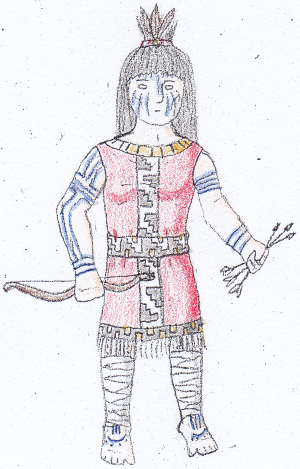Tingreni
Rexlas: Tingrenei /thɪnkrɛːneiː/
The tingreni1 are numerous tribes native to the Tingrenis Plain of eastern Laxilþía. Some of the southern and southwestern tribes are subjects to the empire of Resak, while those on the central plain have resisted its rule for years.
Most of their history since the fall of the memnans and káaxans has been that of endemic warfare between different tribes and, to the south, against Laxúlans, though recently the Rexans from beyond the Katark Mountains have conquered the southwestern tribes and established new provinces on the plain, though not without difficulty as the tingreni are fiercely independent people.
Tattoos are worn by virtually all tingreni, except for those who've adopted rexan culture in the province of Vóx-Tingrenalx.
Each tribe has its patron god or goddess, but most recognize three deities as the most important ones: Grjatta, goddess of fire and the sun; Ete the moon god; and Jinin, a god of war who's described as having blood-red hair, eyes and teeth.
The rexans consider this even more barbaric than the tingreni's reluctance to make human sacrifices, and it's one of the few religious customs which are forbidden in Resak.
The tingreni1 are numerous tribes native to the Tingrenis Plain of eastern Laxilþía. Some of the southern and southwestern tribes are subjects to the empire of Resak, while those on the central plain have resisted its rule for years.
History
Like the Jatrilnúxans in Resak, the tingreni are one of the few people of Laxilþía who were not subjects of the ancient Káaxans during bronze age. Instead, they were influenced by their rivals in the western Katark Mountains, the Memnans.Most of their history since the fall of the memnans and káaxans has been that of endemic warfare between different tribes and, to the south, against Laxúlans, though recently the Rexans from beyond the Katark Mountains have conquered the southwestern tribes and established new provinces on the plain, though not without difficulty as the tingreni are fiercely independent people.
Culture
Apparel
Tingreni clothing is fairly similar for men and women, consisting of little more than short, sleeveless woolen tunic, sash around the waist and wrappings around the legs to protect them from chafing while riding, but footwear is uncommon. The tunics are often decorated with embroidery, fringes and small gold plaques, especially those of chiefs and warriors, and headbands adorned with feathers are popular as well.Tattoos are worn by virtually all tingreni, except for those who've adopted rexan culture in the province of Vóx-Tingrenalx.
Cuisine
Meat, dairy and -to lesser extend- fresh or dried fish are staple food of the tingreni, along with fermented mare milk, variously flavoured with local or imported herbs and spices. Bread is abhorred by most tribes and only in the town of Mefúra do tingreni eat it, often stuffed with onions and sheep brains.Religion
The tingreni perform their rituals atop low step pyramids, but they make no statues or altars for their gods and favour animal rather than human sacrifice; the last detail is considered especially strange by the rexans. All religious ceremonies are performed under the influence of hallucinogenics.Each tribe has its patron god or goddess, but most recognize three deities as the most important ones: Grjatta, goddess of fire and the sun; Ete the moon god; and Jinin, a god of war who's described as having blood-red hair, eyes and teeth.
Funerary practices
The tingreni practice cannibalism as part of their funeral rites, as they believe that consuming the flesh of their dead prevents their soul from wandering around as a vengeful spirit, and ensures that a part of that person's essence lives on among their people. This is especially important for warriors, who are expected to eat a part of their fallen enemies after a duel as a sign of respect for their combat skills, but refusing to do so is considered among the gravest insults in tingreni society.The rexans consider this even more barbaric than the tingreni's reluctance to make human sacrifices, and it's one of the few religious customs which are forbidden in Resak.
Warfare
The tingreni are widely considered some of -if not the- best archers in Laxilþía, both on foot and on horseback. Children are taught how to shoot arrows at early age, and in some tribes are not allowed any food except what they can hunt with their own bow. Although the majority of warriors are men, it's not unusual for women to fight as well.1Original icelandic: Tingrenar, singular: Tingreni
Related Organizations
Languages spoken
Related Locations





Comments